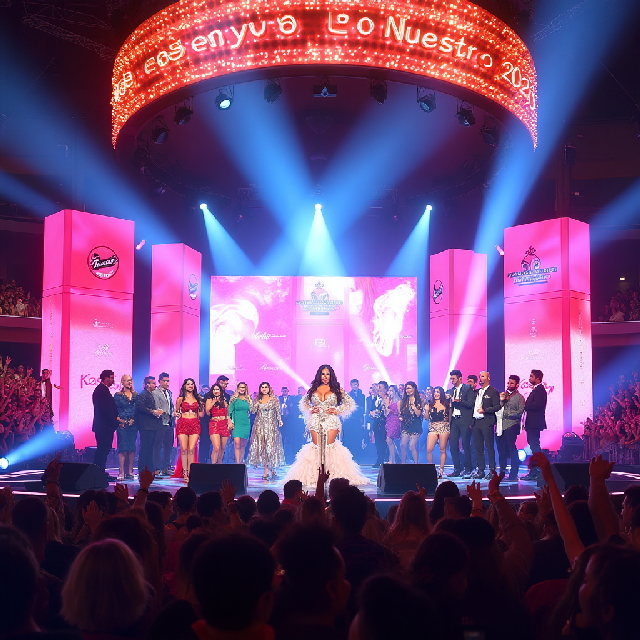Premio Lo Nuestro 2025: A Night of Latin Music Excellence 🌟
The 37th edition of Premio Lo Nuestro was held at the Kaseya Center in Miami on February 20, 2025. Themed “Uniting Generations,” this ceremony celebrated Latin music’s rich heritage and its dynamic future. The event brought together iconic artists and emerging talents for a night of captivating performances, heartfelt tributes, and well-deserved accolades.
Introduction: Setting the Stage
Miami’s vibrant energy set the perfect backdrop for an evening that honored both legends and newcomers. The theme “Uniting Generations” was evident from the start, as the ceremony seamlessly blended classic tributes with modern performances, creating a bridge between past and present.
Captivating Performances: A Symphony of Emotions
The night was a testament to the power of live music, with each performance telling a unique story. Becky G electrified the stage with her dynamic blend of pop and Latin rhythms, while Thalía captivated audiences with her timeless voice and commanding presence. Their performances were not just entertaining but also a celebration of cultural heritage.
Becky G: A Modern Maestro
With her magnetic stage presence, Becky G seamlessly transitioned from powerful ballads to high-energy anthems. Her ability to connect with both younger and older audiences highlighted her role as a bridge between generations.
Thalía: The Timeless Queen
Known as the “Queen of Latin Pop,” Thalía delivered a performance that was nothing short of mesmerizing. Her voice soared through classic hits, evoking nostalgia in long-time fans while drawing in new listeners with her infectious energy.
Major Winners: Celebrating Excellence and Legacy
The awards ceremony was a celebration of artistic excellence, with each winner’s contributions adding depth to Latin music’s landscape.
🌟 Shakira: The Queen of the Night
Shakira, the undisputed star, took home six awards, including “Album of the Year” for Las Mujeres Ya No Lloran. Her ability to reinvent herself while maintaining a deep connection with her audience solidified her status as a legend. Each award was a testament to her innovative spirit and enduring impact.
🎶 Carín León: A Champion of Mexican Music
With five wins, Carín León celebrated the richness of regional Mexican music. His album Boca Chueca, Vol. 1 stood out for its authenticity and contribution to keeping traditional sounds alive in modern times.
🔥 Karol G: Breaking Barriers
Karol G’s four awards, including “Artist of the Year,” marked her continued influence on Latin music. Her journey as a trailblazer inspires millions, proving that innovation and resilience can lead to extraordinary success.
🎵 Camilo: A Tropical Triumph
Camilo’s four wins highlighted his unique blend of traditional and modern elements. His album Cuatro captivated global audiences, showcasing the enduring appeal of tropical music with a contemporary twist.
Cultural Impact: Beyond the Stage
Premio Lo Nuestro is more than an awards show; it’s a cultural phenomenon that unites communities through music. This year’s ceremony paid homage to icons like Paquita la del Barrio, celebrating resilience and tradition. Emotional tributes, such as Pepe Aguilar’s heartfelt performance, reminded us of the power of music to transcend generations and borders.
The event also served as a platform for addressing social issues, with artists advocating for unity and equality. This cultural impact extends beyond the stage, influencing conversations around identity and representation.
Unifying Generations Through Music
From legendary performances by Alejandro Fernández to groundbreaking collaborations by modern artists like Carín León, Premio Lo Nuestro 2025 was a celebration of Latin music’s past, present, and future. The ceremony’s mix of classic tributes and innovative performances ensured every generation felt represented.
The blend of timeless rhythms and contemporary beats highlighted how Latin music remains a universal language, connecting us all through shared experiences and emotions.
Celebrating Musical Heritage
Premio Lo Nuestro honored the rich musical heritage that defines Latin culture. From Celia Cruz’s pioneering work to Bad Bunny’s global influence, the event showcased evolution while staying true to roots. The introduction of six new categories reflected the genre’s diversity, embracing both traditional styles and modern trends.
Conclusion: A Legacy of Unity and Excellence
Premio Lo Nuestro 2025 was a vibrant celebration of Latin music’s legacy and cultural richness. It reminded us that music has no boundaries and that when generations unite, magic happens. Here’s to another year of incredible music and shared experiences that inspire and connect us.
Let us know your favorite Premio Lo Nuestro moment in the comments! 💬
#PremioLoNuestro2025 #LatinMusicExcellence #Shakira #CarinLeon #KarolG #Camilo

How did Premio Lo Nuestro 2025’s mix of classic tributes and modern performances reflect its “Uniting Generations” theme? Did it bridge gaps between age groups? Were organizers able to balance both elements for a cohesive experience, ensuring traditional fans and younger audiences felt equally engaged? Or did one overshadow the other? Were there standout moments where classic and modern styles merged seamlessly?
The Premio Lo Nuestro 2025 aimed to unite generations with a mix of classic tributes and modern acts. Featuring legends like Thalía and newcomers like Becky G, it’s interesting to see how the event balanced old-school fans’ tastes with younger audiences’. Did organizers find ways to blend these styles seamlessly, ensuring neither group felt overshadowed? Were there standout moments where classic and contemporary elements merged perfectly?
Premio Lo Nuestro 2025 tried to bridge generational gaps by mixing legendary artists like Thalía with modern stars like Becky G. I’m curious if their performances felt cohesive for all viewers or came off as two separate groups under one theme.
Premio Lo Nuestro 2025 mixed classic tributes with modern acts. Was the blend smooth or did it seem like separate segments for different age groups? Did constant genre switches and stage changes add variety or make the show feel disjointed?
How did the audience react—did they like the mix or find it overwhelming?